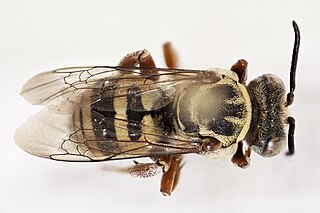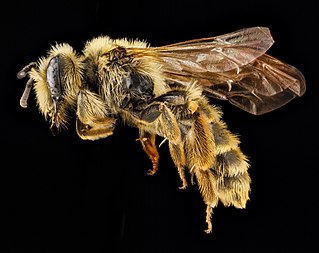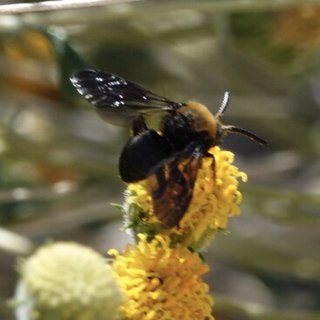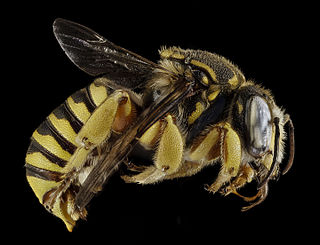
Calathus is a genus of ground beetle native to the Palearctic, the Near East and North Africa. There are at least 190 described species in Calathus.

Cassida is a large Old World genus of tortoise beetles in the subfamily Cassidinae. Several species of Cassida are important agricultural pests, in particular C. vittata and C. nebulosa on sugar beet and spinach. The thistle tortoise beetle has been used as a biological control agent against Canada thistle.
Trachusa perdita, the California leafcutting bee, is a species of bee in the family Megachilidae.
Hesperapis is a genus of evening bees in the family Melittidae. There are at least 30 described species in Hesperapis.
Trachusa fontemvitae is a species of leafcutter, mason, and resin bees in the family Megachilidae. It is found in North America.

Anthidiini is a tribe of insects in the family Megachilidae. There are at least 40 genera and 840 described species in Anthidiini.

Trachusa is a genus of leafcutter, mason, and resin bees in the family Megachilidae. There are at least 50 described species in Trachusa.

Xeromelecta is a genus of digger-cuckoo bees in the family Apidae. There are about six described species in Xeromelecta.
Melecta edwardsii, or Edward's melectum, is a species of digger-cuckoo bee in the family Apidae. It is found in Central America and North America.
Perdita larreae is a species of bee in the family Andrenidae. It is found in Central America and North America.
Calliopsis linsleyi, or Linsley's nomadopsis, is a species of mining bee in the family Andrenidae. It is found in Central America and North America.

Triepeolus martini is a species of cuckoo bee in the family Apidae. It is found in Central America and North America.
Clematodes larreae, the gray creosotebush grasshopper, is a species of short-horned grasshopper in the family Acrididae. It is found in North America.

The death camas miner bee, is a species of miner bee in the family Andrenidae. Another common name for this species is death camas andrena. It is found in North America. It specialises in feeding on the highly poisonous Toxicoscordion venenosum and is possibly the only bee that can tolerate its toxins.

Xeromelecta larreae, the larrea xeromelecta, is a species of hymenopteran in the family Apidae. It is found in Central America and North America.

Ancylandrena is a genus of mining bees in the family Andrenidae. There are about five described species in Ancylandrena.
Ancylandrena larreae, the creosote bush ancylandrena, is a species of mining bee in the family Andrenidae. It is found in Central America and North America.

Trachusa dorsalis is a species of bee in the family Megachilidae. It is found in North America.

Trachusa zebrata is a species of bee in the family Megachilidae. It is found in North America.
Trachusa cordaticeps is a species of bee in the family Megachilidae. It is found in Central America and North America.









